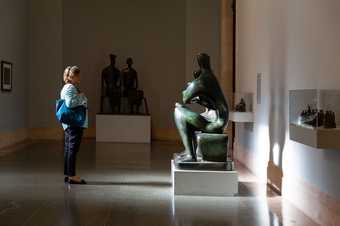
© Rikard Österlund
Henry Moore at Tate
Uncover the history of Henry Moore’s relationship with Tate and how the collection of his work was formed
The first room of the Henry Moore display reveals the history of the artist’s relationship with Tate and how the collection of his work was formed.
Moore built a close relationship with the Gallery: he served as a Trustee for two terms from 1941–56, and two large-scale retrospective exhibitions of his work were held in 1951 and 1968.
The most recent exhibition in 2010 at Tate Britain re-affirmed Moore’s status as one of the leading artists of the twentieth century.
Henry Moore’s friends and supporters were pivotal in shaping Tate’s collection of Moore’s work. Moore also donated sets of prints to the gallery in 1976 and his most significant act of generosity was the presentation of 36 sculptures in 1978.
Today, the Tate collection owns over 600 works ranging in date from 1921 to 1984, and including drawings, prints, and sculptures in wood, stone and metal.
Tate Britain
Main Floor
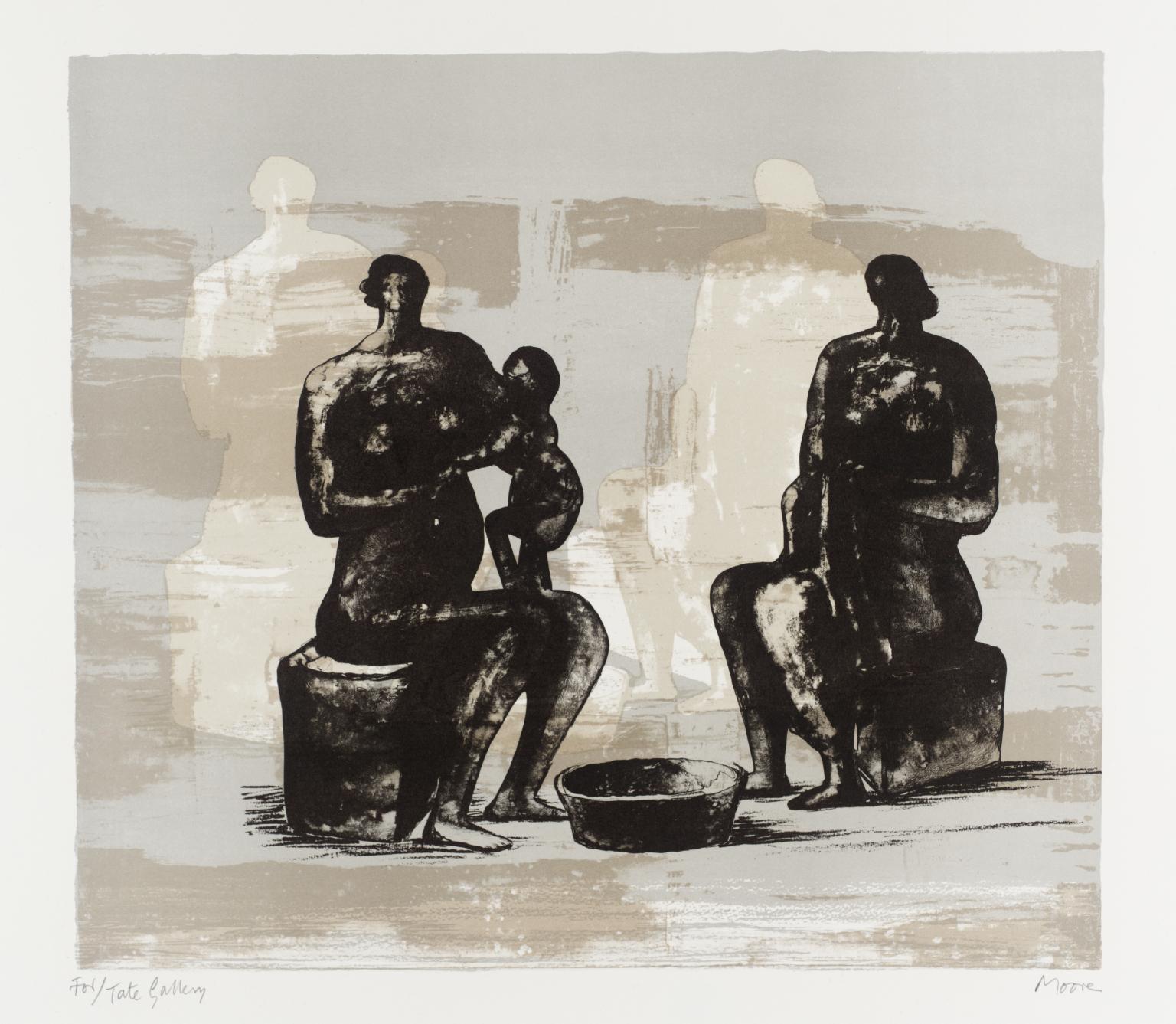
Henry Moore OM, CH, Two Women Bathing Child I 1973
1/30
artworks in Henry Moore at Tate
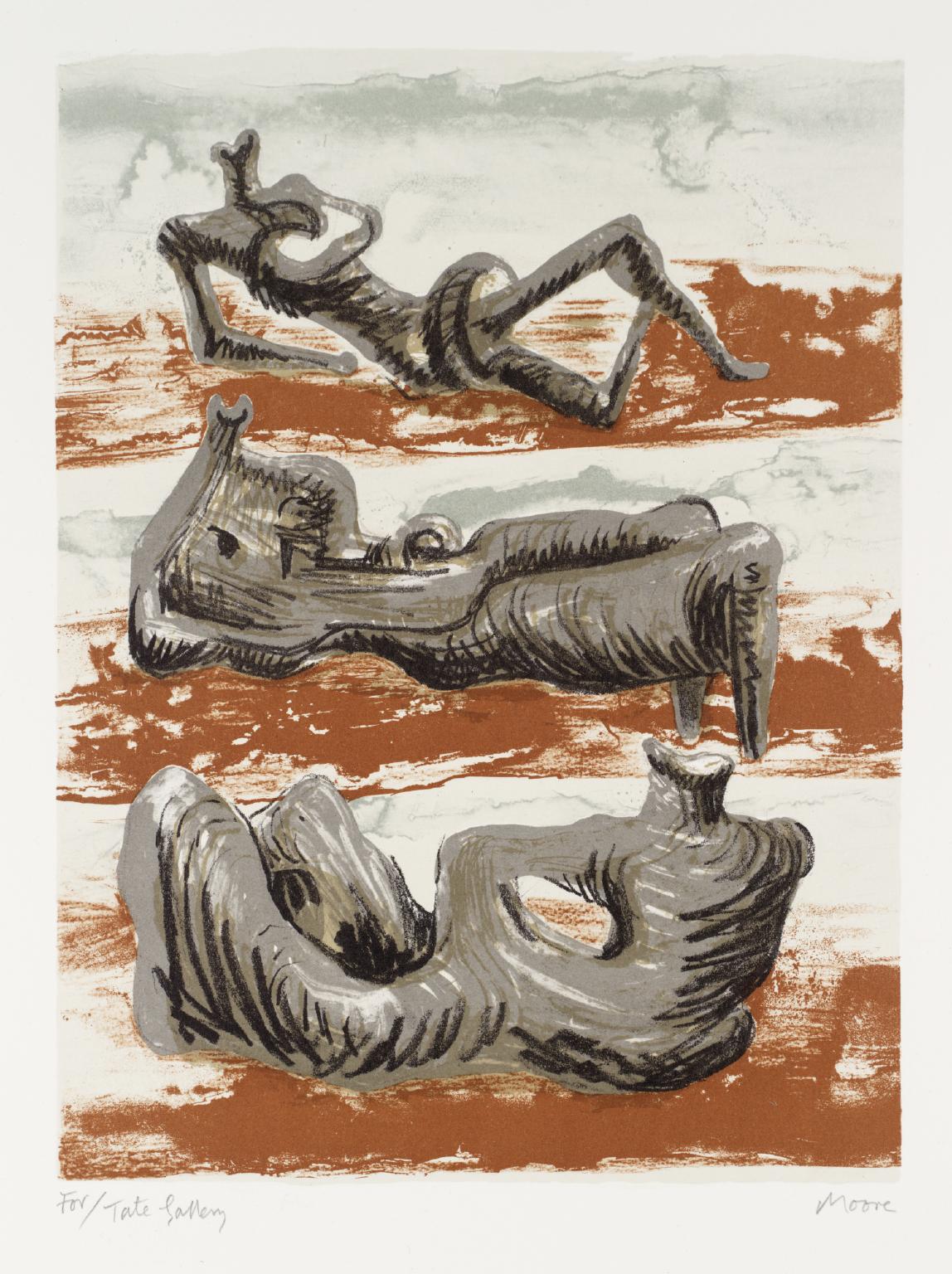
Henry Moore OM, CH, Three Reclining Figures 1975
2/30
artworks in Henry Moore at Tate
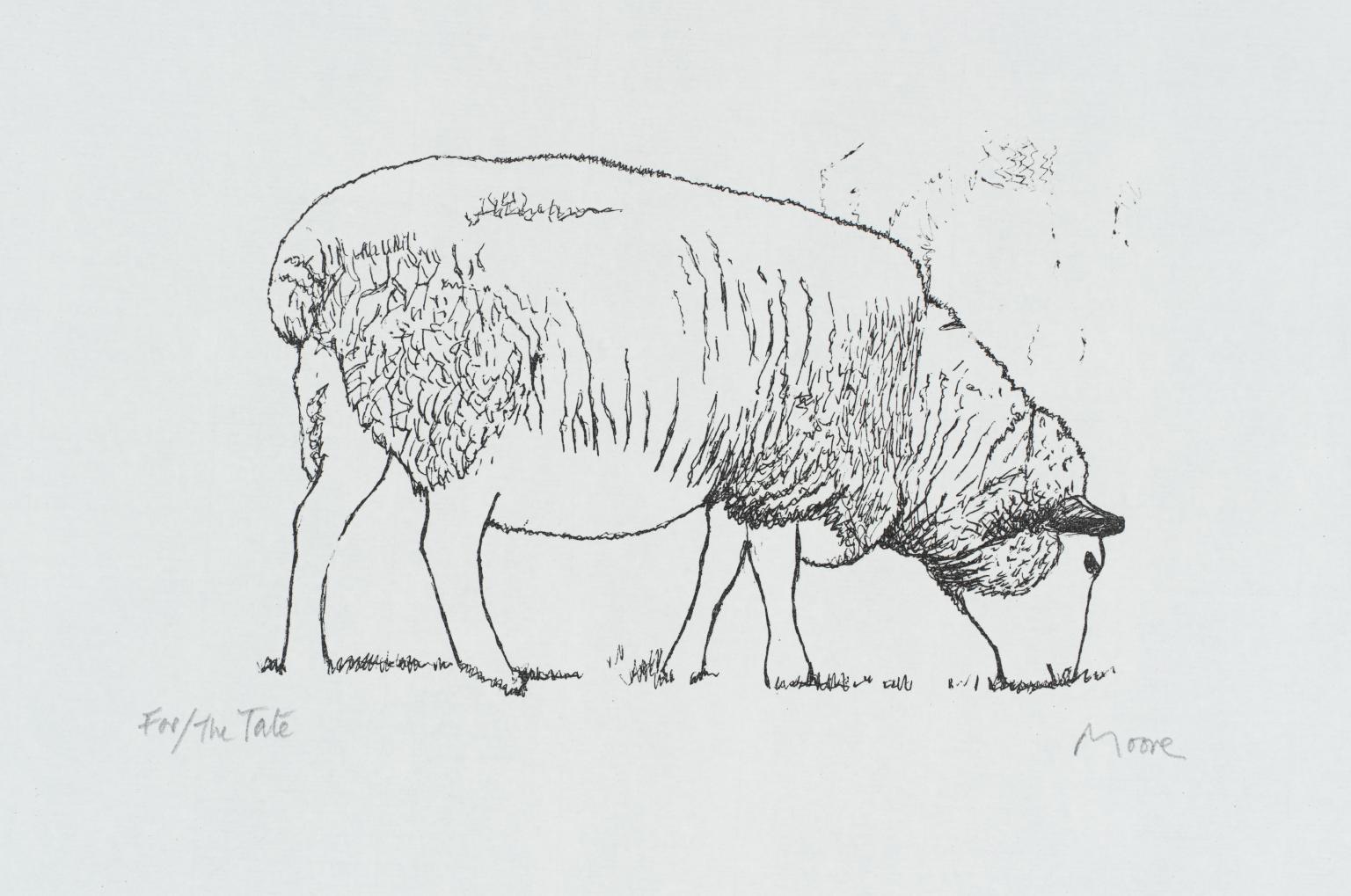
Henry Moore OM, CH, Sheep Grazing 1974
3/30
artworks in Henry Moore at Tate

Henry Moore OM, CH, Stone II 1977
4/30
artworks in Henry Moore at Tate
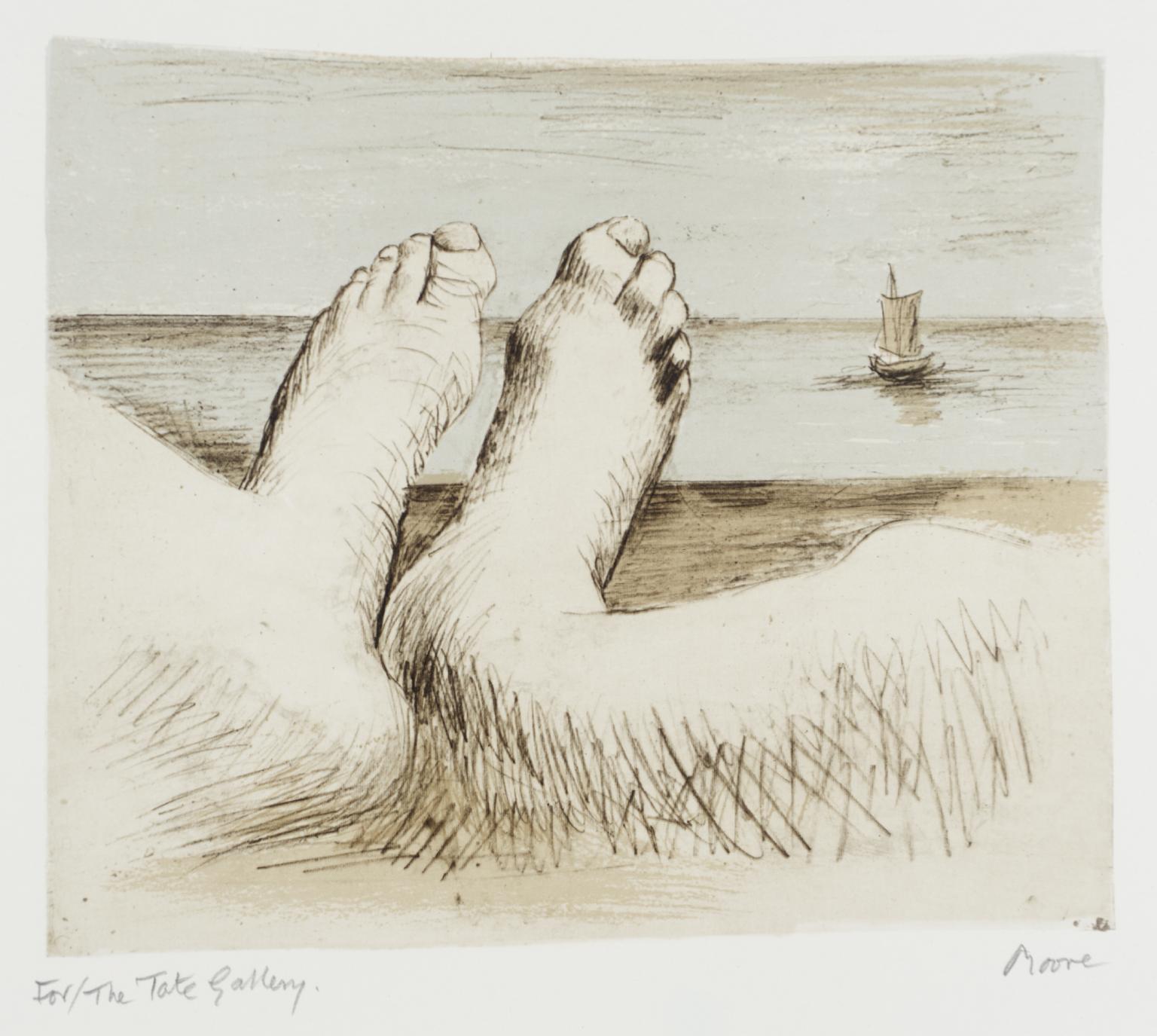
Henry Moore OM, CH, Feet on Holiday II 1979
5/30
artworks in Henry Moore at Tate
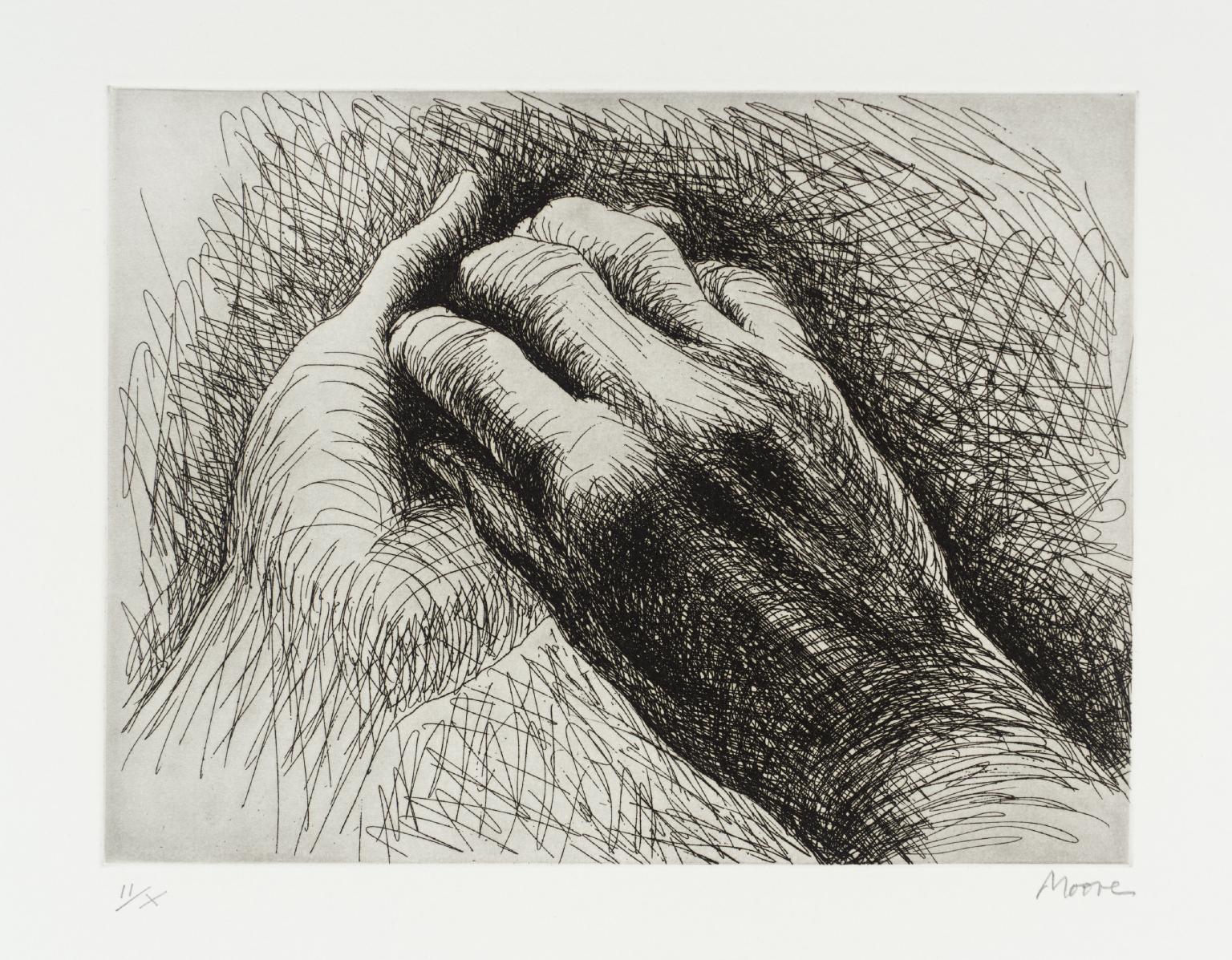
Henry Moore OM, CH, The Artist’s Hand II 1979
Henry Moore's subject is the aged body. He made these drawings of his own hands when he was eighty-one and suffering from ill-health. 'Hands can convey so much' he said, 'they can beg or refuse, take or give, be open or clenched, show content or anxiety. They can be young or old, beautiful or deformed'.
Moore saw these prints as belonging to a long tradition of fascination with hands as vehicles of expression: 'Throughout the history of sculpture and painting one can find that artists have shown through the hands the feelings they wished to represent.'
Gallery label, September 2004
6/30
artworks in Henry Moore at Tate
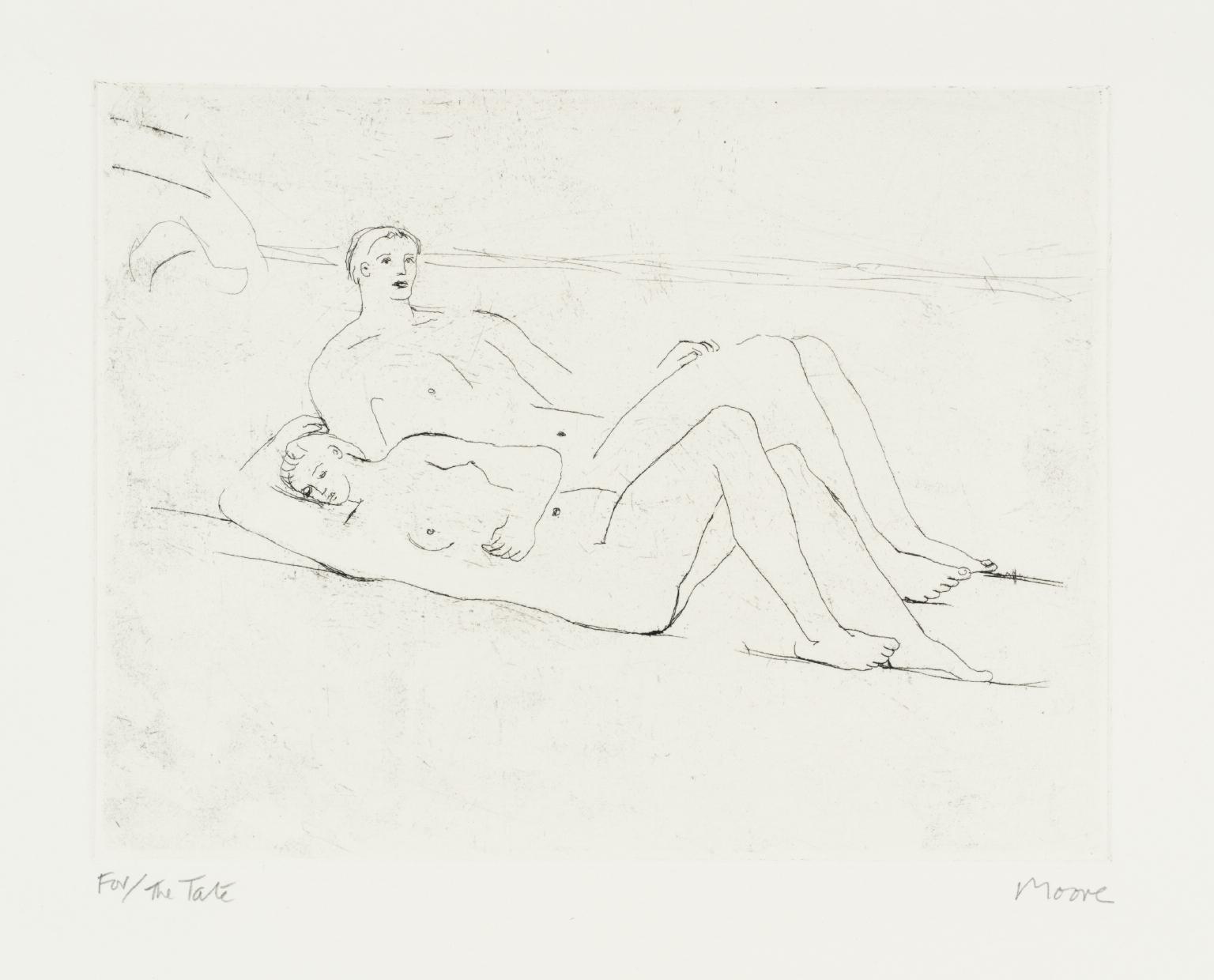
Henry Moore OM, CH, Reclining Figures on Beach 1975–6
7/30
artworks in Henry Moore at Tate
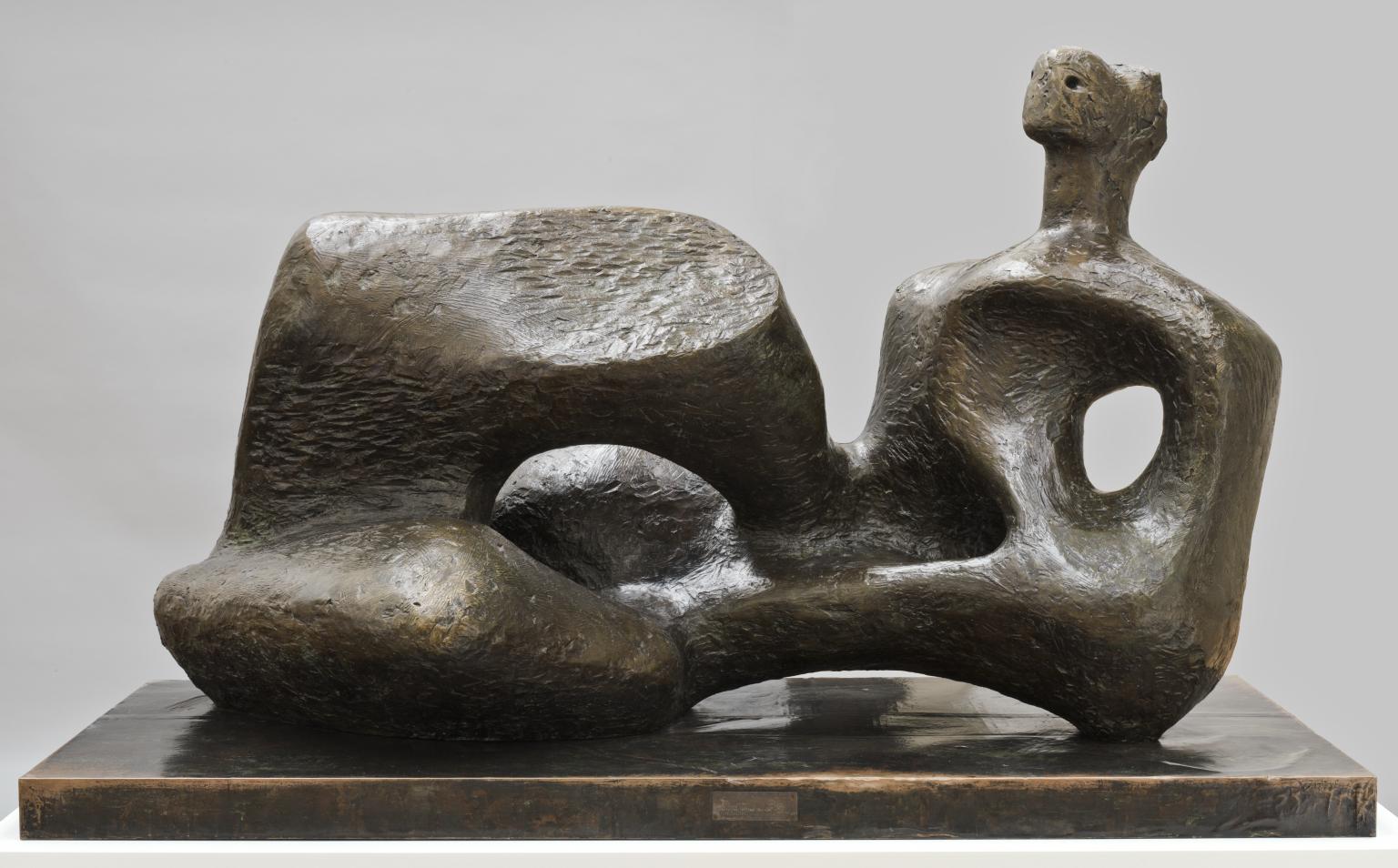
Henry Moore OM, CH, Working Model for Unesco Reclining Figure 1957, cast c.1959–61
This sculpture is related to the UNESCO Reclining Figure at UNESCO’s Paris headquarters shown in the photograph above. That work is carved from travertine marble and is unique. This smaller bronze sculpture is in an edition of six. As with his other public sculptures Moore sought to avoid narrative or overt rhetoric. The universal significance attributed to Moore’s sculpture made it particularly appropriate for a global organisation such as UNESCO.
Gallery label, September 2004
8/30
artworks in Henry Moore at Tate
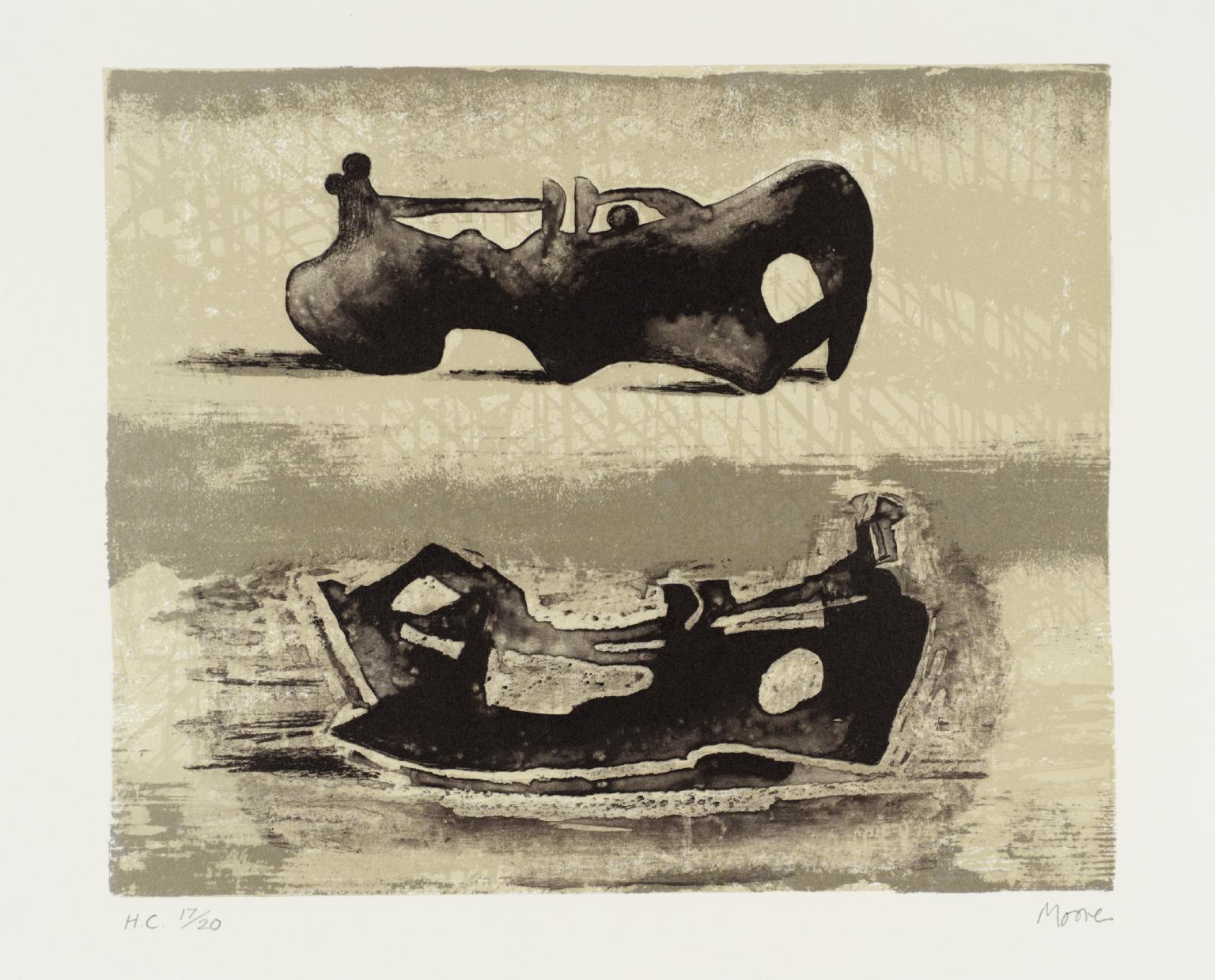
Henry Moore OM, CH, Two Reclining Figures 1976
9/30
artworks in Henry Moore at Tate
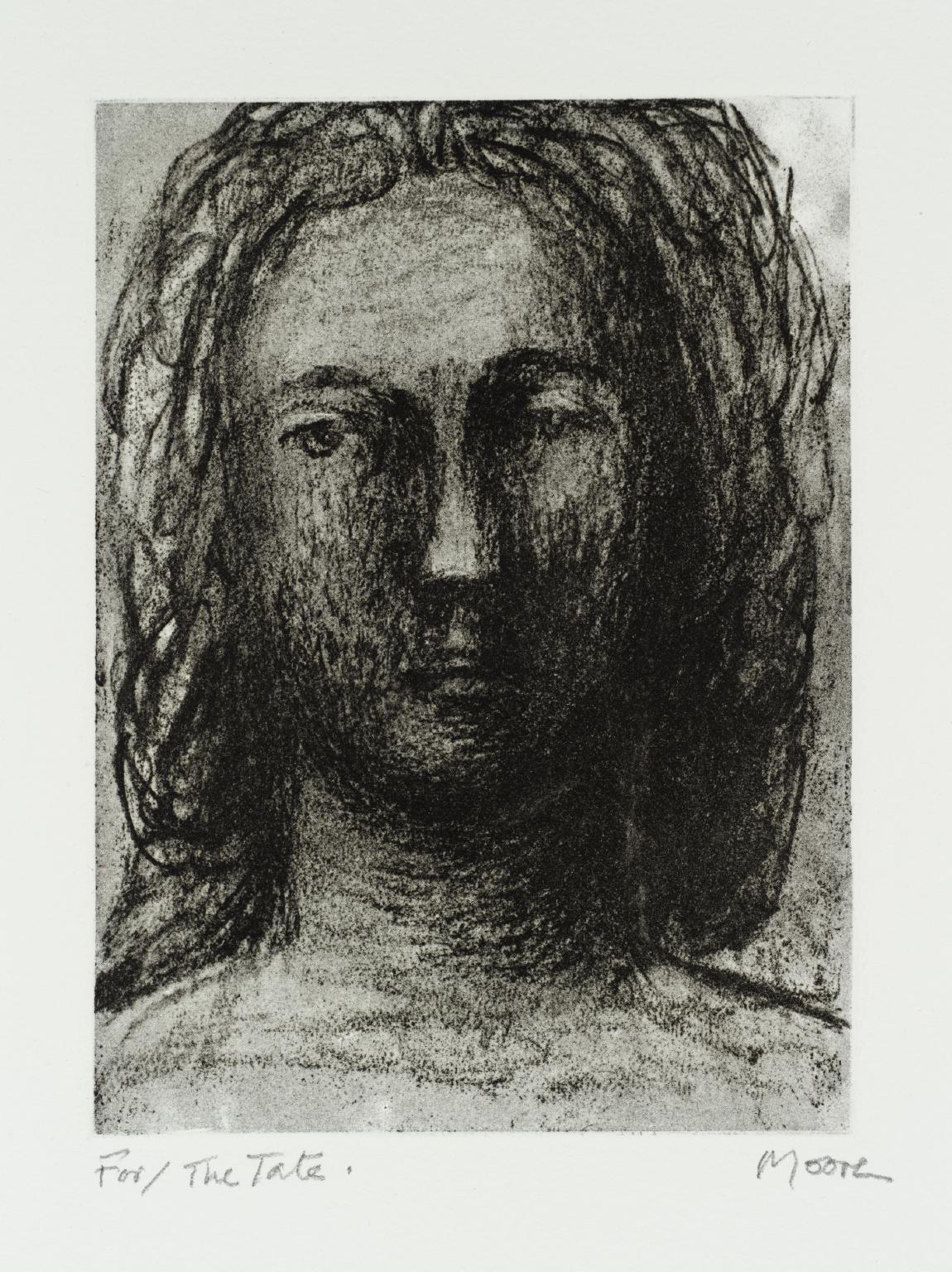
Henry Moore OM, CH, Head of Girl III 1981
10/30
artworks in Henry Moore at Tate
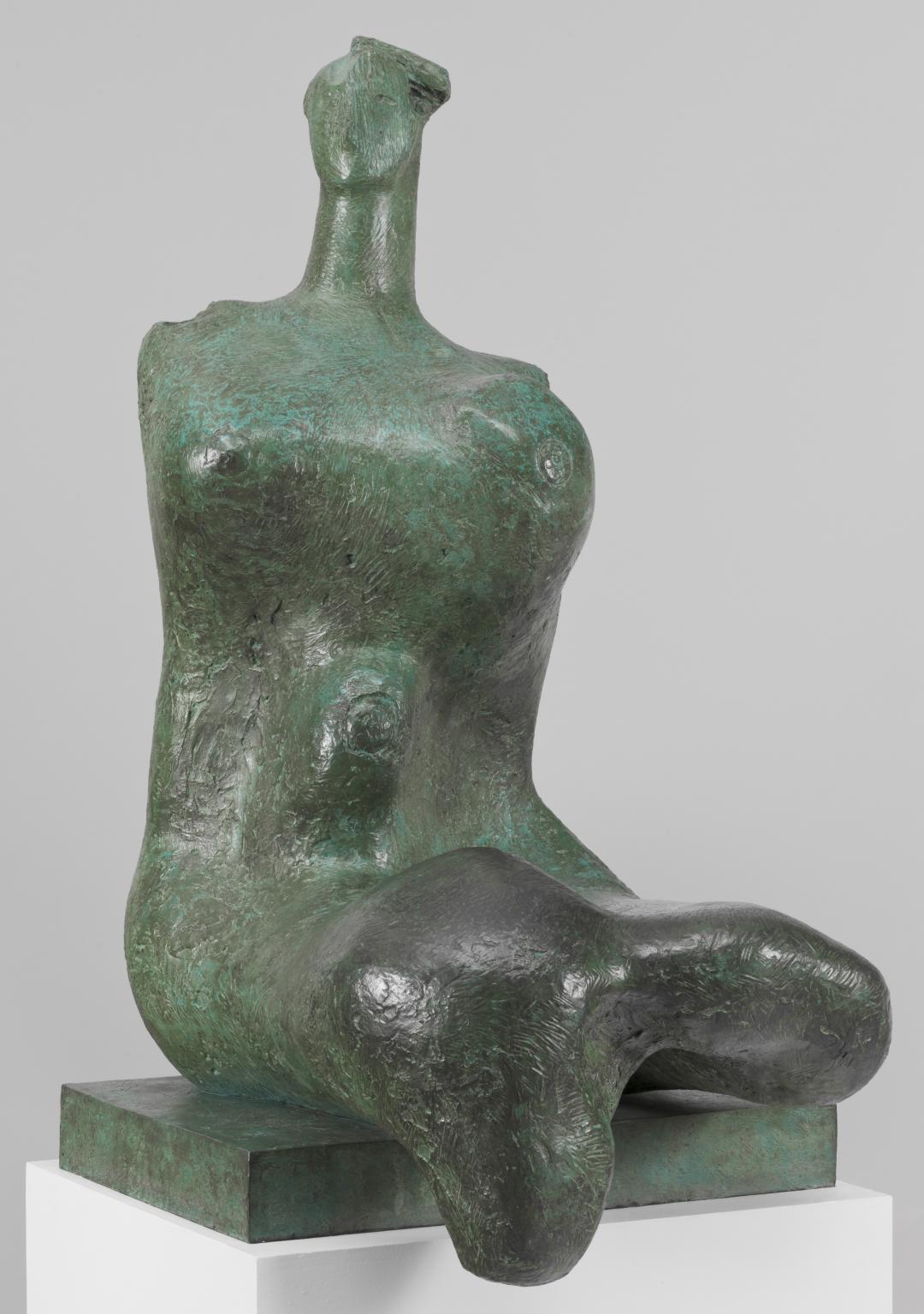
Henry Moore OM, CH, Woman 1957–8, cast date unknown
This is one of the largest of Moore's sculptures of a seated female nude, and it was cast in an edition of nine. The original plaster is in the Art Gallery of Ontario, Toronto, and the curator there, Alan Wilkinson, has described this sculpture as 'one of the most potent images of fertility produced in the 20th century'. He also related it to Moore's early interest in Palaeolithic sculpture, an influence the artist readily acknowledged. Moore wrote of the work: ''Woman' has that startling fullness of the stomach and breasts. The smallness of the head is necessary to emphasize the massiveness of the body - if the head had been any larger it would have ruined the whole idea of the sculpture.'
Gallery label, September 2004
11/30
artworks in Henry Moore at Tate
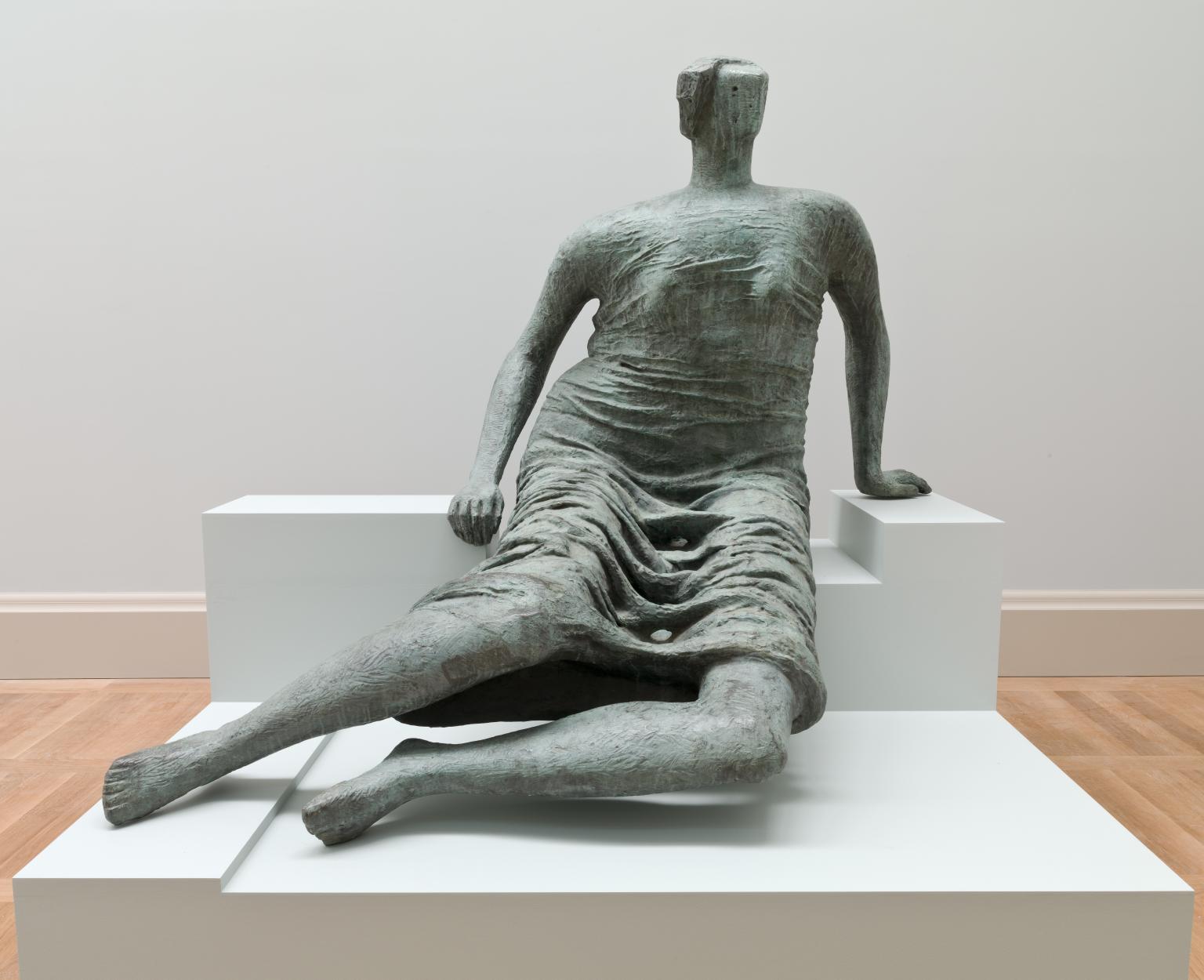
Henry Moore OM, CH, Draped Seated Woman 1957–8, cast c.1958–63
Two casts of this monumental female figure have been sited in public urban spaces: one in Wuppertal in Germany, another in the East End of London. London County Council’s policy of placing such work in deprived areas was part of a post-war revival of civil aspirations and social reform.
Gallery label, June 2003
12/30
artworks in Henry Moore at Tate
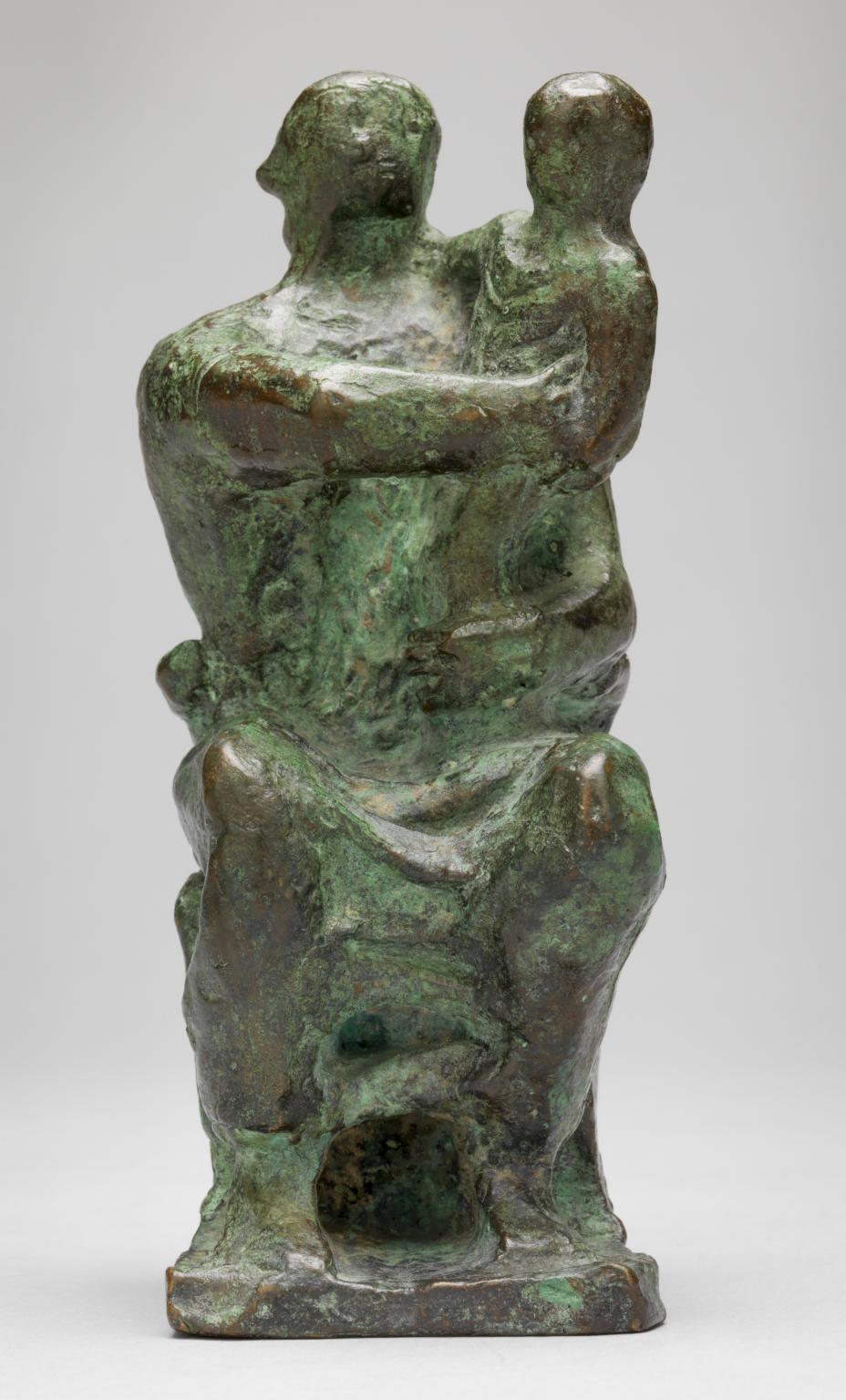
Henry Moore OM, CH, Maquette for Madonna and Child 1943, cast 1944–5
The mother and child had been a major theme in Moore’s work since the 1920s. Yet when the vicar of St Matthew, Northampton, invited Moore to make a sculpture of the Madonna and Child, he was reluctant to accept. He felt unsure how to adapt his secular interests to the Christian tradition. These bronzes are casts of the original terracotta models he made for the project. They are unusually naturalistic and steeped in references to Renaissance religious art. This suggests Moore was trying to produce a sculpture that people would find both modern and familiar.
Gallery label, September 2016
13/30
artworks in Henry Moore at Tate

Henry Moore OM, CH, Family Group 1949, cast 1950–1
Family Group is derived from one of a number of maquettes that Moore made for a sculpture for Impington Village College in Cambridgeshire. In the end none of them was accepted. Several years later, however, he was approached to make a sculpture for the Barclay Secondary School in Stevenage and returned to the theme. The bronze was cast in an edition of four. One is still at the Barclay Secondary School. The others were acquired by the Museum of Modern Art in New York, Nelson D Rockefeller, and Tate.
Gallery label, September 2004
14/30
artworks in Henry Moore at Tate
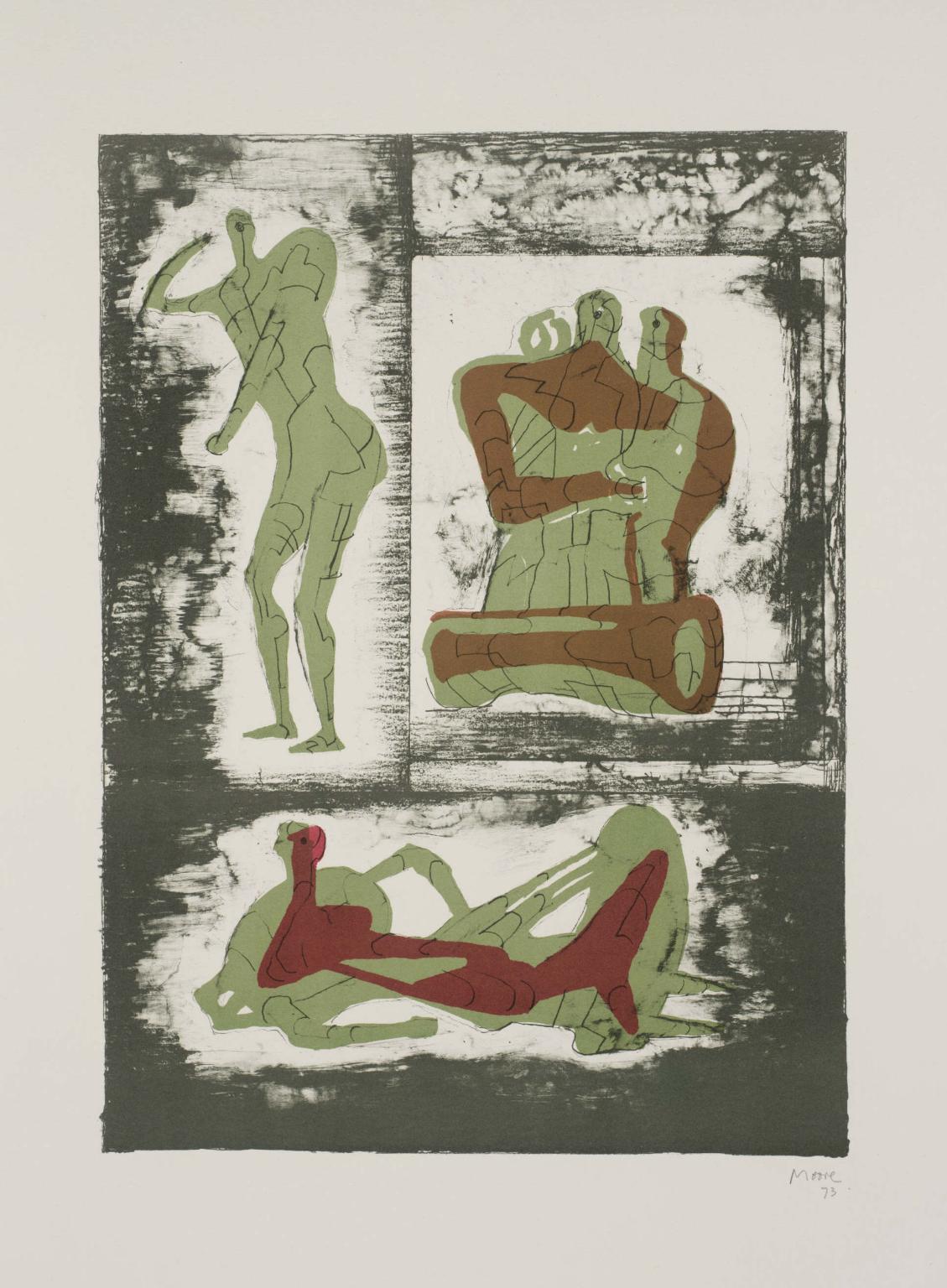
Henry Moore OM, CH, Reclining & Standing Figure and Family Group 1973
15/30
artworks in Henry Moore at Tate
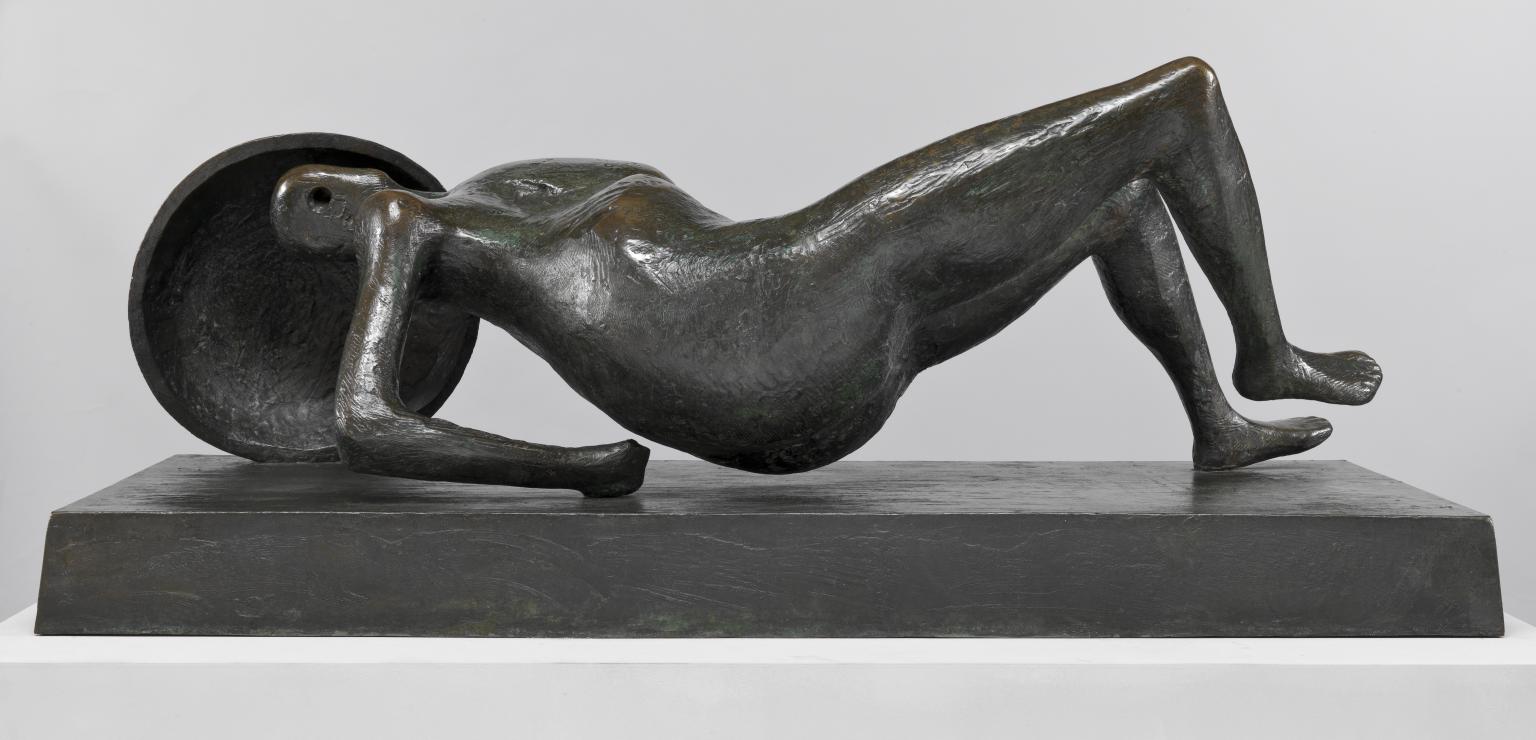
Henry Moore OM, CH, Falling Warrior 1956–7, cast c.1957–60
The sense of movement in this pose was very important for Henry Moore. He said, ‘I wanted a figure that was still alive... [I made] the action that of a figure in the act of falling, and the shield became a support for the warrior, emphasising the dramatic moment that precedes death.’ Moore only ever created six sculptures of large male figures. Falling Warrior is one of them, one of only three to show the male figure alone.
Gallery label, February 2025
16/30
artworks in Henry Moore at Tate
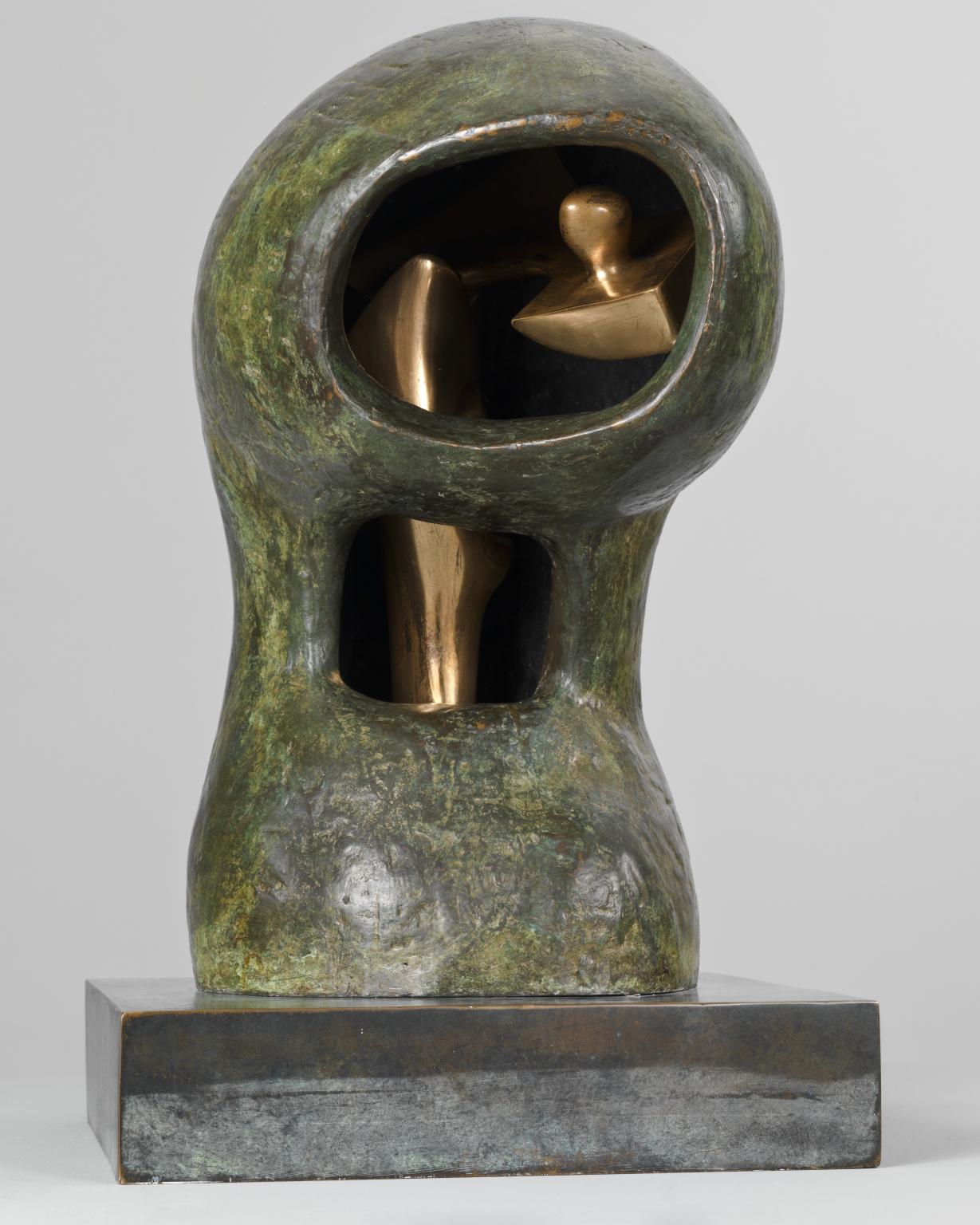
Henry Moore OM, CH, Helmet Head No.4: Interior-Exterior 1963, cast date unknown
This work is part of a series Henry Moore created in which a hard outer ‘helmet’ shell encloses a smaller, contrasting ‘head’ form within. According to Moore, ‘the idea of one form inside another form may owe some of its incipient beginnings to my interest at one stage when I discovered armour. I spent many hours in the Wallace Collection, in London, looking at armour.’ In the context of Moore’s other work, this series can also be seen as an abstract development of the theme of mother and child.
Gallery label, February 2025
17/30
artworks in Henry Moore at Tate
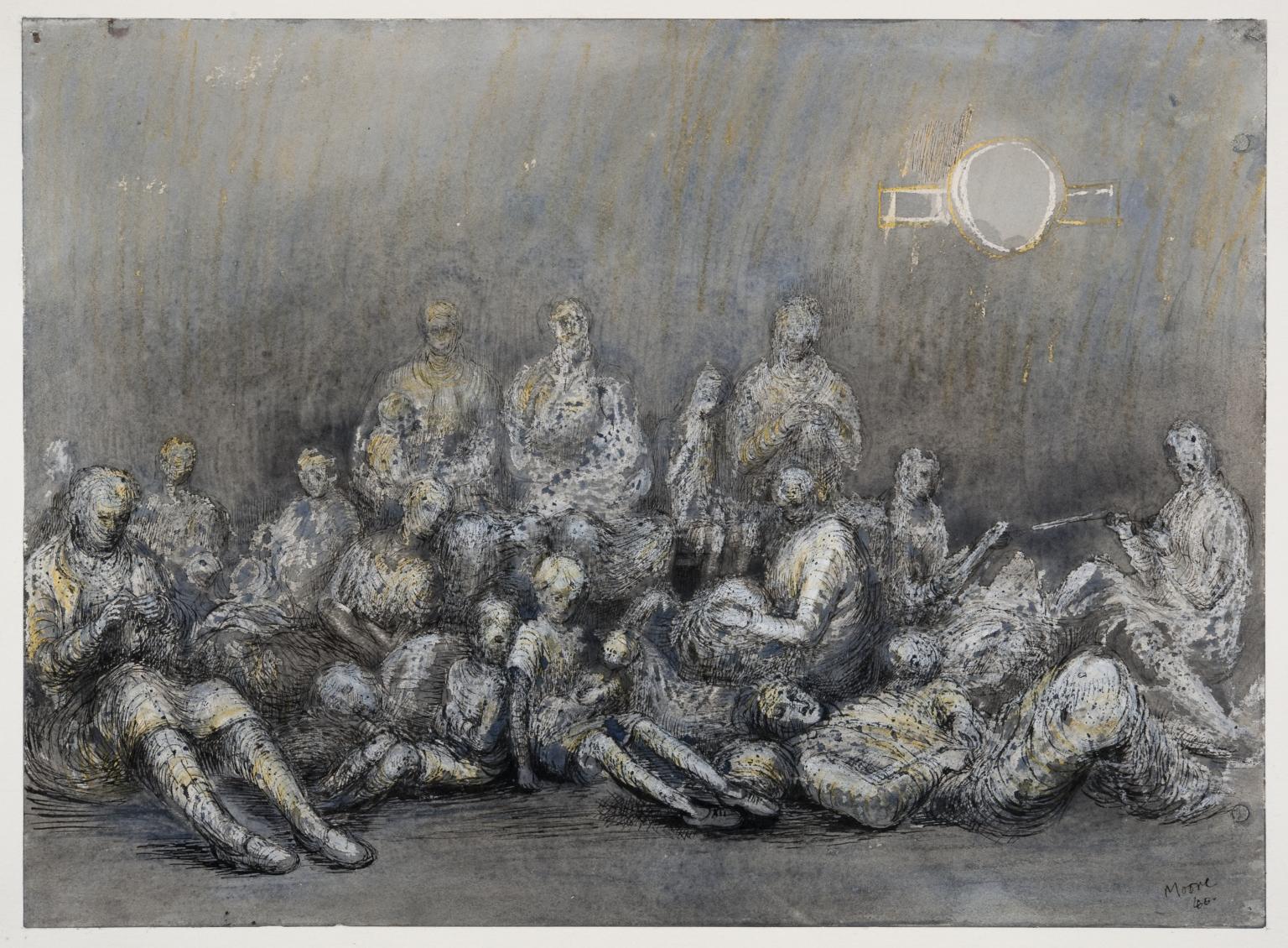
Henry Moore OM, CH, Grey Tube Shelter 1940
In autumn 1940, Moore took cover from an air raid in Belsize Park underground station. He was 'fascinated by the sight of people camping out deep under ground'. On returning to his studio, he made some drawings from memory. When Kenneth Clark, Director of the National Gallery and Chairman of the War Artists Advisory Committee, saw the pictures, he commissioned further drawings and appointed Moore as an official war artist. These drawings were exhibited in 1941 in the empty halls of the National Gallery whose artworks had been temporarily removed because of the war.
Gallery label, January 2025
18/30
artworks in Henry Moore at Tate
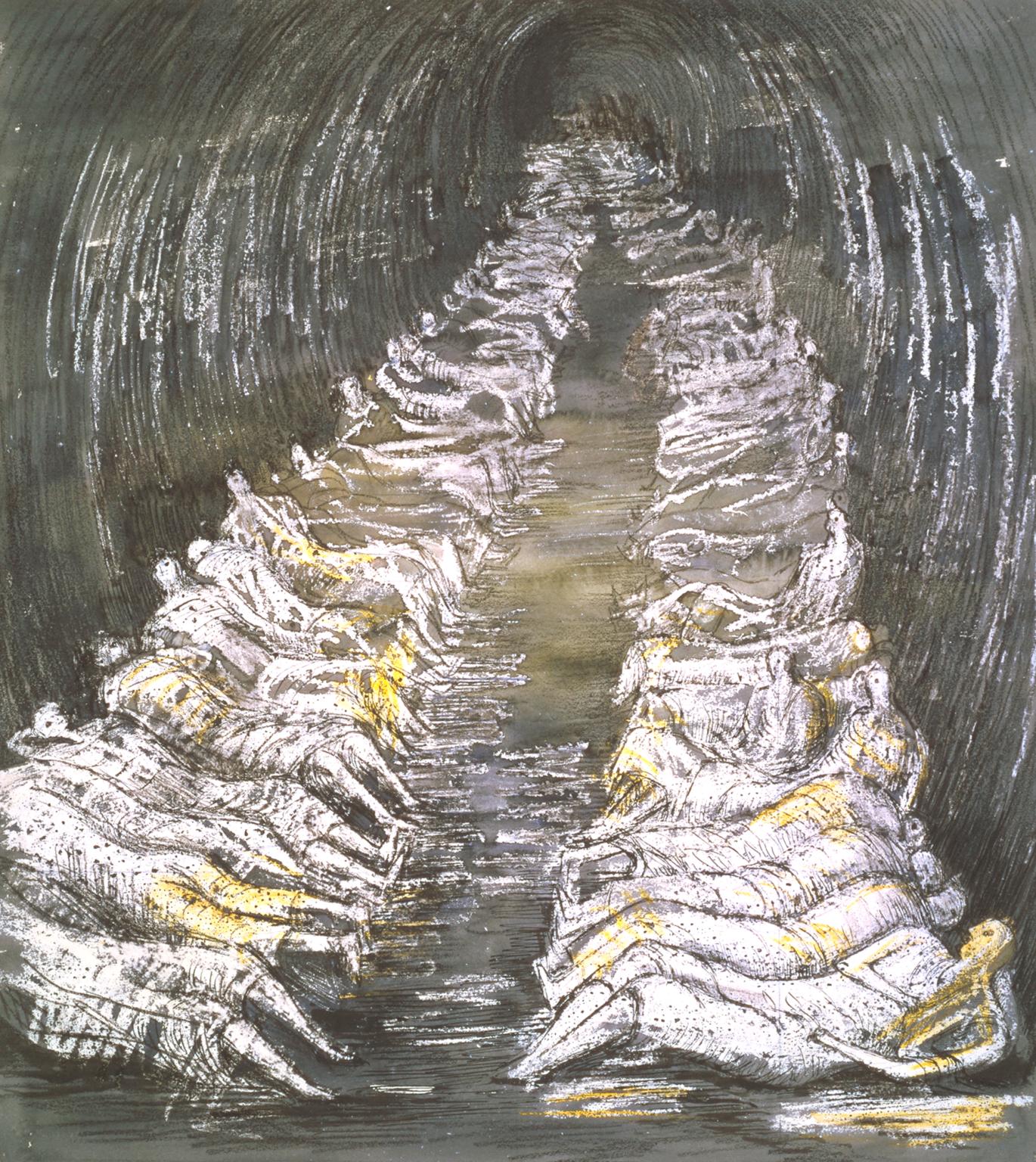
Henry Moore OM, CH, Tube Shelter Perspective 1941
This drawing of people sheltering in an underground station during the Second World War was exhibited at the National Gallery in 1941. The exhibition catalogue described it as 'a terrifying vista of recumbent shapes, pale as all underground life tends to be pale; regimented, as only fear can regiment; helpless yet tense, safe yet listening, uncouth, uprooted, waiting in the tunnel for the dawn to release them. This is not the descriptive journalism of art. It is imaginative poetry of a high order.'
Gallery label, January 2025
19/30
artworks in Henry Moore at Tate
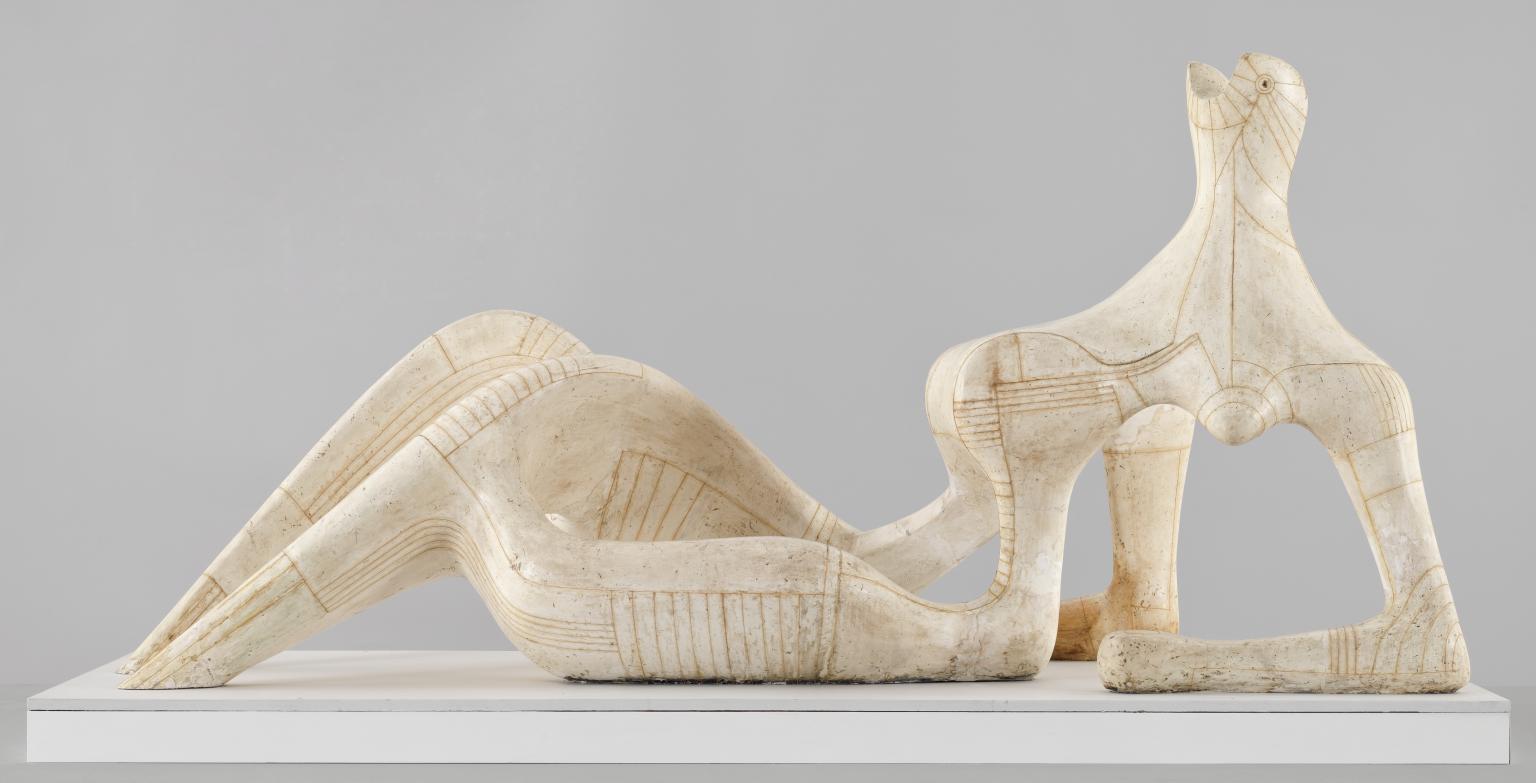
Henry Moore OM, CH, Reclining Figure 1951
In the late 1940s, the Arts Council invited Moore to submit ideas for a sculpture to be sited at the South Bank site of the Festival of Britain. Although the organising committee suggested a family theme, Moore chose to make this tense, skeletal reclining form. The work on display is the plaster model for the bronze, which was cast in an edition of five.
Gallery label, September 2004
20/30
artworks in Henry Moore at Tate
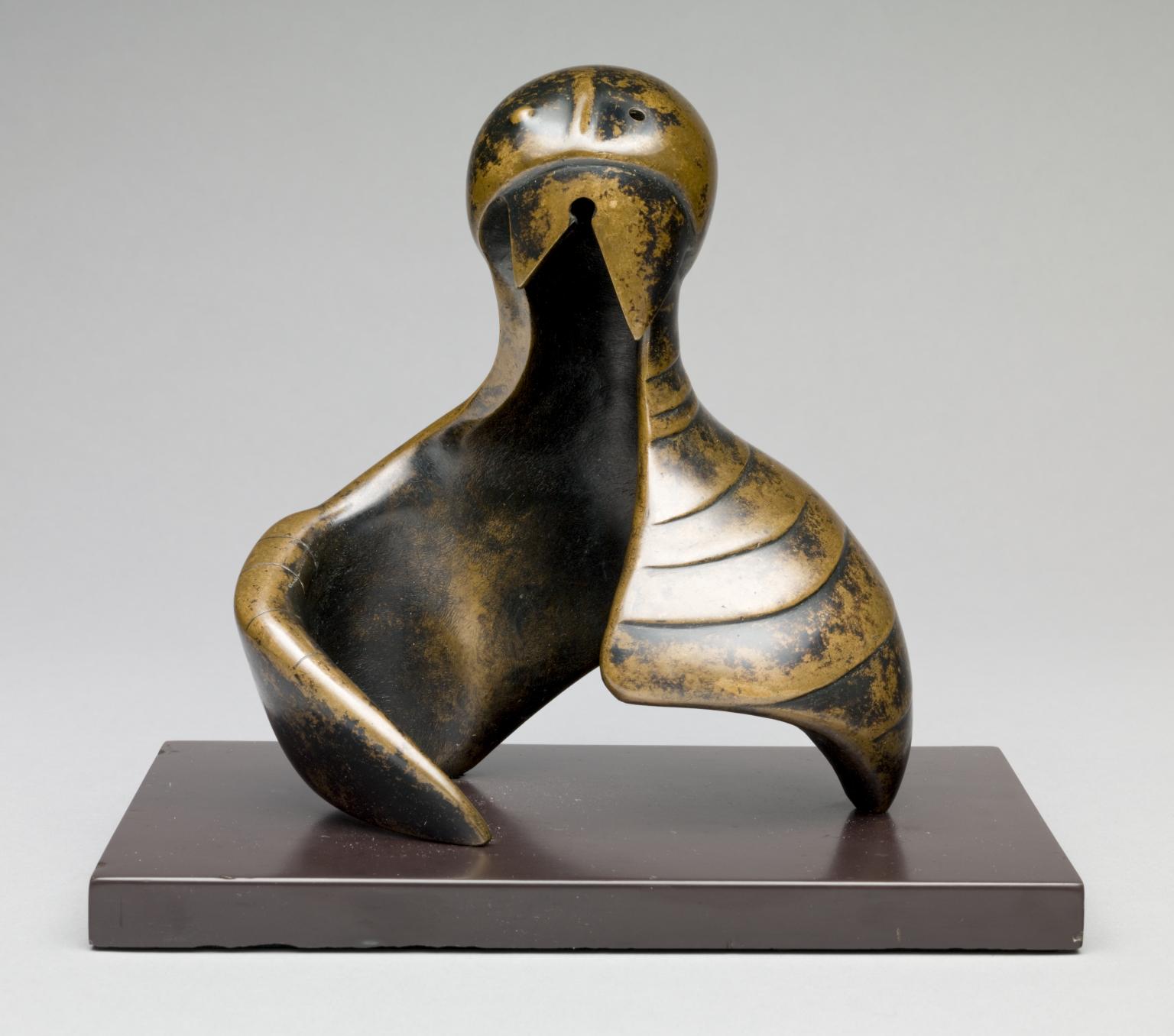
Henry Moore OM, CH, Helmet Head and Shoulders 1952, cast date unknown
Henry Moore first explored the theme of helmets and the bodies they protect in the late 1930s, in the run-up to the Second World War. He returned to it in the 1950s, in the war’s aftermath. Where his pre-war helmets contain a complex series of forms, his post-war helmets, such as this one, are hollowed out. The helmet’s asymmetrical curves highlight the void inside and its uneven lines give it the feeling of recovered battlefield debris.
Gallery label, February 2025
21/30
artworks in Henry Moore at Tate
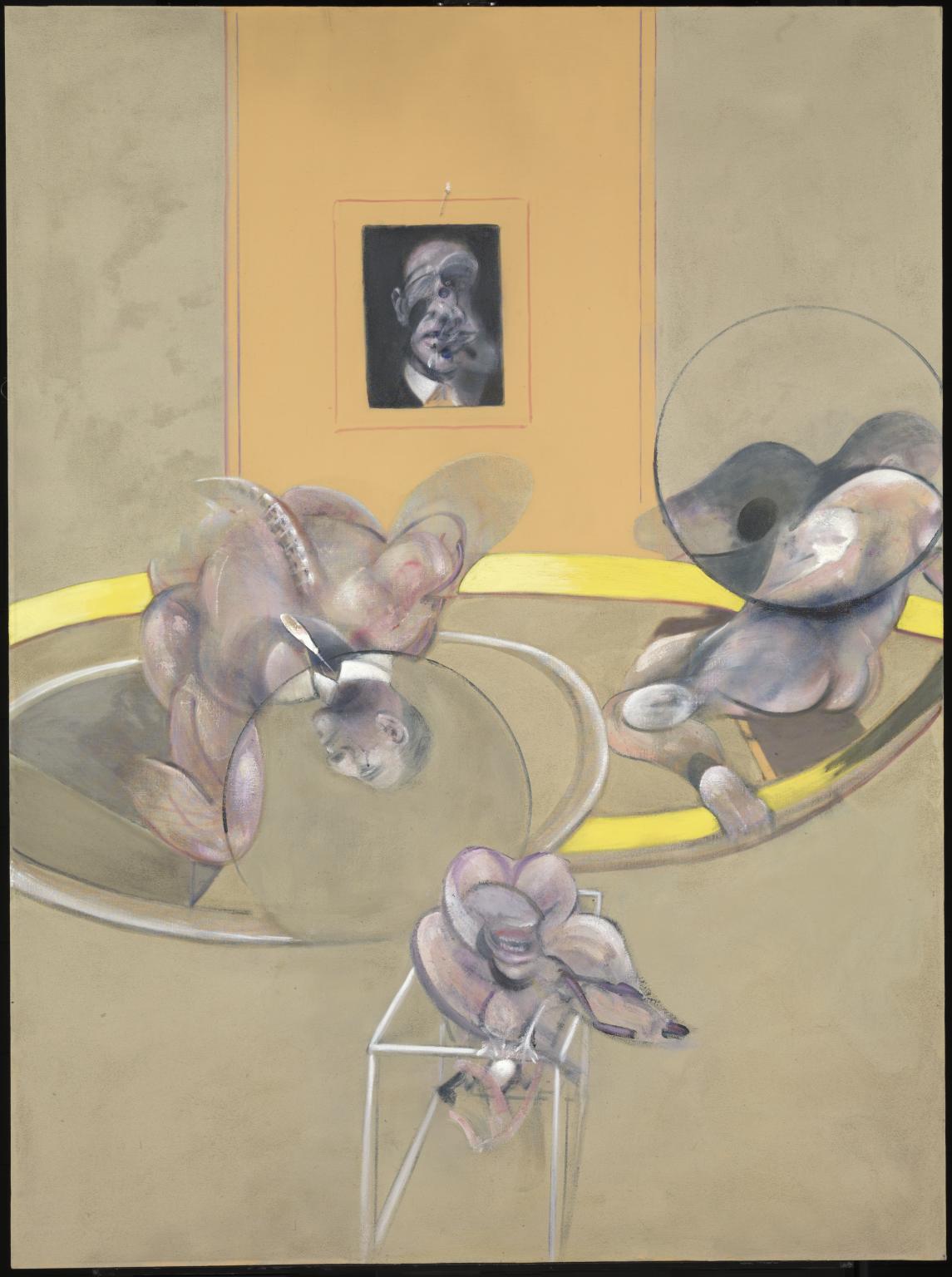
Francis Bacon, Three Figures and Portrait 1975
Two dynamic figures and bird-like creature are placed within a claustrophobic setting. The three figures are watched over by a portrait. This work is usually seen as an image of suffering. One - and possibly both - of the twisting human figures have been identified as George Dyer, Bacon’s companion, lover and muse. Dyer killed himself in 1971, but Bacon continued to portray him after his death. The bird-like form in the foreground, with its snarling human mouth, has been linked to the Furies, goddesses of vengeance in Greek mythology.
Gallery label, June 2021
22/30
artworks in Henry Moore at Tate
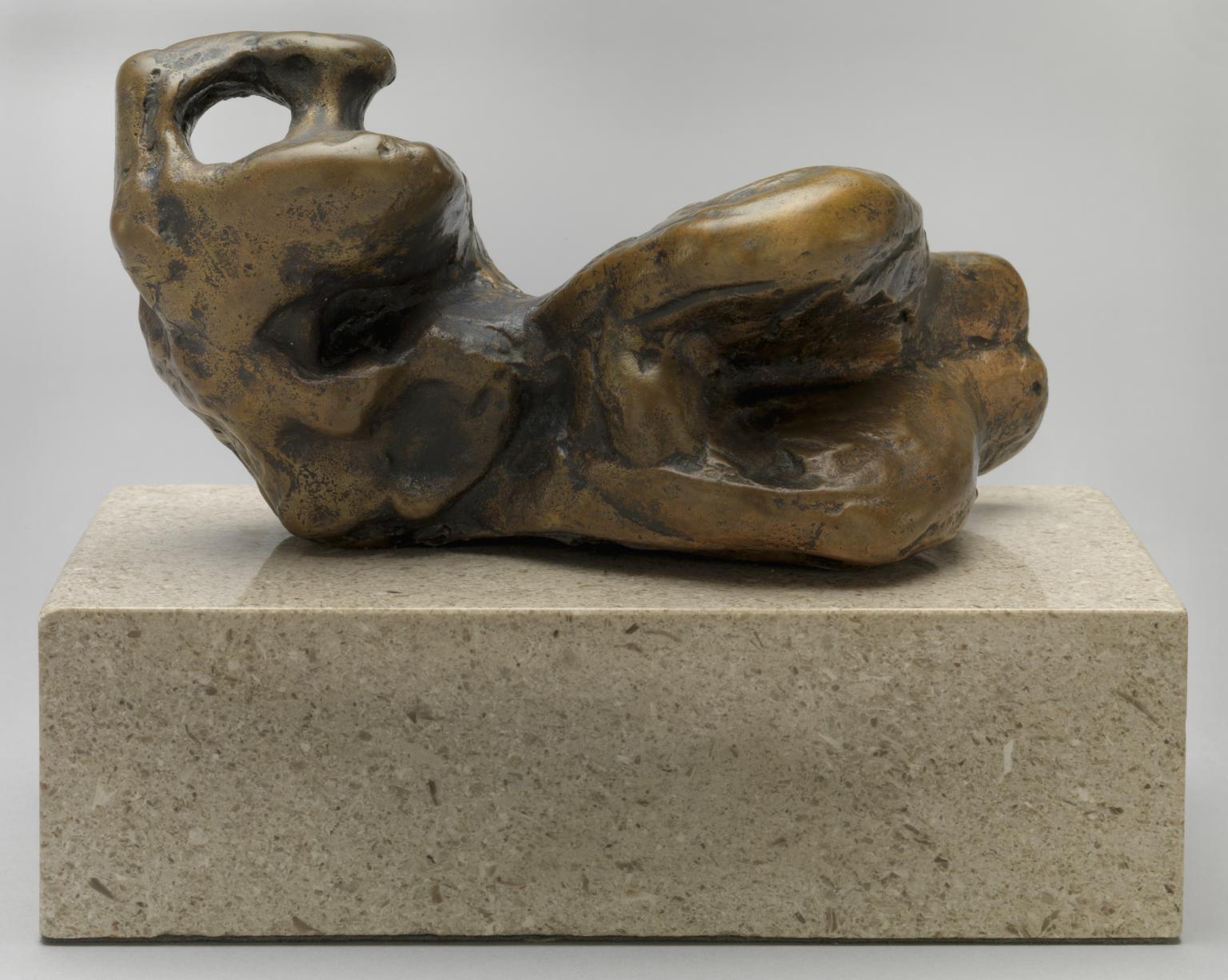
Henry Moore OM, CH, Reclining Figure: Bunched 1961, cast 1961–2
By the mid-1950s Moore had almost entirely eliminated drawing from his creative process and explored his ideas through small maquettes. These had an intrinsic quality of immediacy or spontaneity and allowed him to imagine the finished product in the round. In order to translate the scale of the work more effectively, he often made larger working models as an intermediate stage between the maquette and the finished sculpture. Moore’s maquettes were typically cast in bronze in editions of up to ten. The sculptor strove for monumentality in his work and tried to imbue the same quality in the small maquettes. He also took a great deal of care with their finish. Some were more polished than others, some darker, some greener. Moore did all the patination himself, treating the bronze with different acids to achieve different effects then working on it by hand, rubbing and wearing it down.
Gallery label, September 2004
23/30
artworks in Henry Moore at Tate
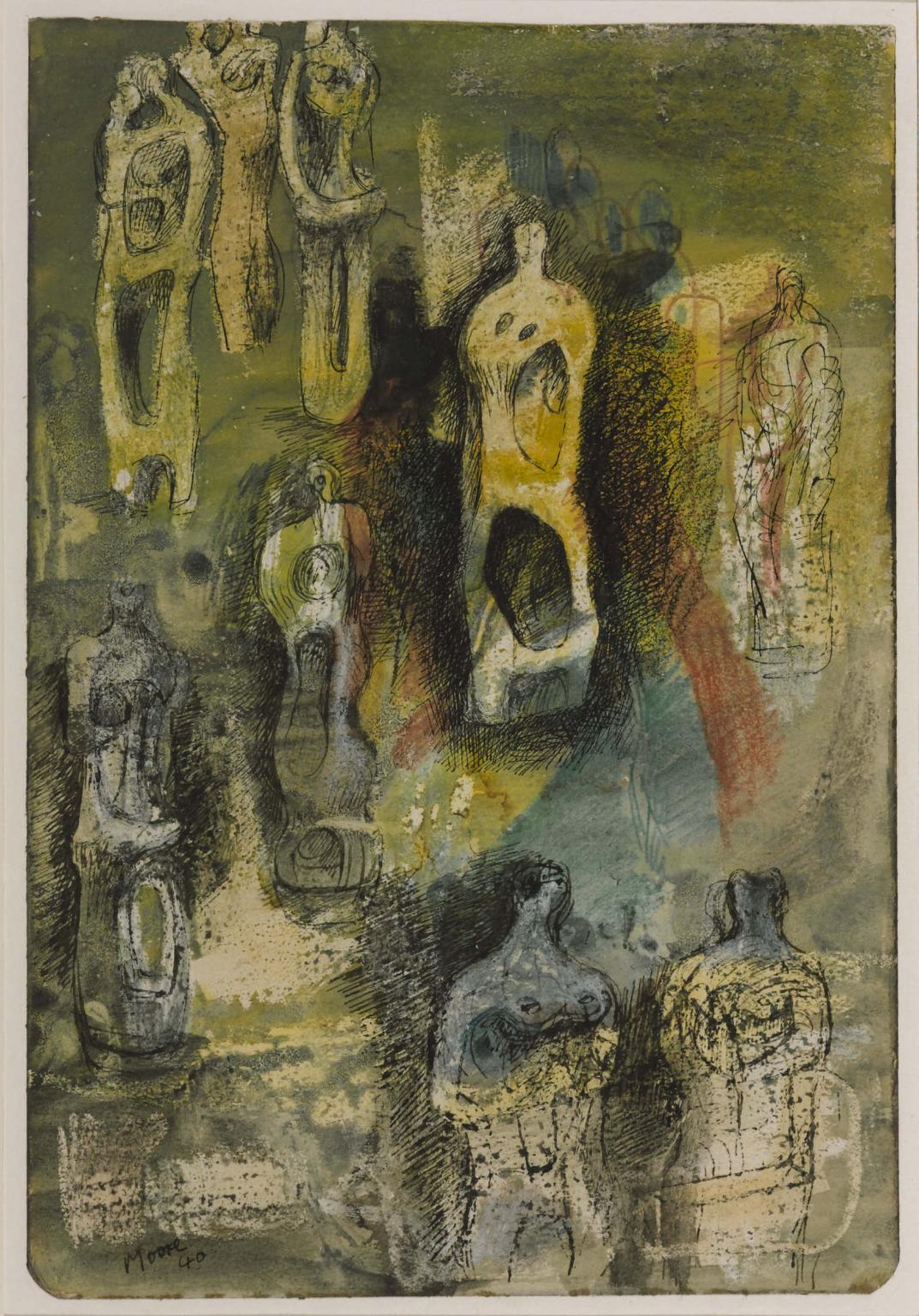
Henry Moore OM, CH, Standing Figures 1940
Henry Moore used drawing as an investigative process where he could think through new works. These half-finished sketches represent his ideas for future carvings in wood. They evoke fragmented bones or human forms whose ghostly appearance reflects his mood during the Second World War. The conditions of war prevented Moore from producing any sculptures until the Madonna and Child projects of 1943, also on display in this gallery.
Gallery label, January 2025
24/30
artworks in Henry Moore at Tate

Francis Bacon, Dog 1952
Throughout his career, Francis Bacon included animals in his paintings to represent the wildness of human emotion. Here, Bacon viscerally smears paint to suggest a snarling dog, evoking aggression, vulnerability or both. The image comes from Eadweard Muybridge's 1887 time-lapse photographs of animals in motion. Bacon isolates the dog, placing it in an ambiguous setting based on the sea front in Monte Carlo, where he lived from 1946 to 1950.
Gallery label, August 2024
25/30
artworks in Henry Moore at Tate
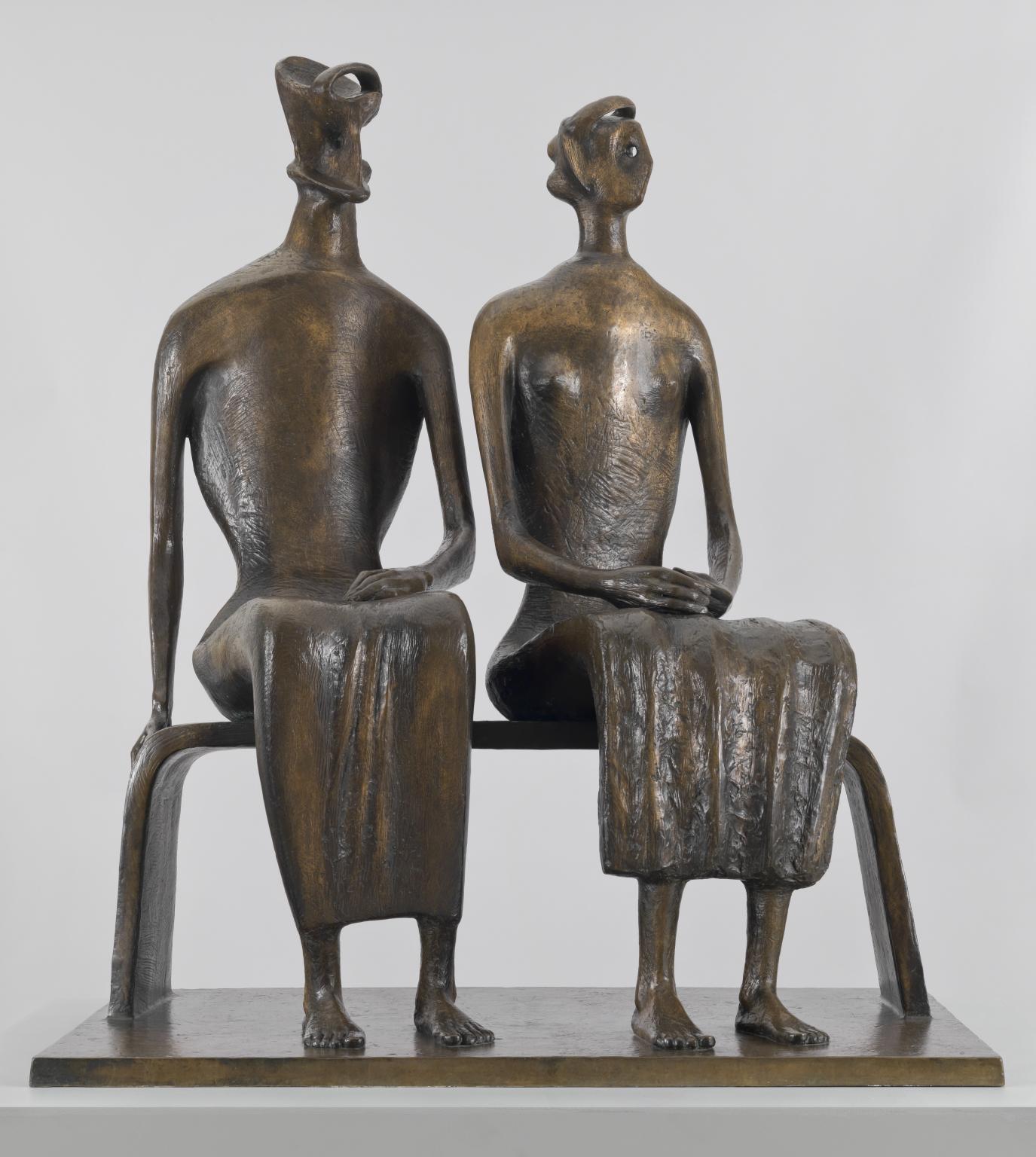
Henry Moore OM, CH, King and Queen 1952–3, cast 1957
According to Henry Moore, this sculpture was inspired by ancient representations of monarchs. He said it was ‘connected with the archaic... idea of a king... the head of the king which is a head and a crown, face and beard combined into one form.’ Although Moore emphasised anonymous and universal themes of rulership, he created King and Queen around the same time as the coronation of Queen Elizabeth II. Images of the ceremony were widely published in the media.
Gallery label, February 2025
26/30
artworks in Henry Moore at Tate

Henry Moore OM, CH, Mother and Child 1953, cast c.1954
Many of Henry Moore’s sculptures show a nurturing mother-child relationship. Mother and Child depicts a darker and more disturbing dynamic. Moore wanted to explore the more complex side of rearing a child. Sometimes, he said, ‘it’s as though they want to devour their parent... as though the parent, the mother, had to hold the child at arm’s length.’ The jagged style enhances the menacing feeling of the figures and their relationship to one another.
Gallery label, February 2025
27/30
artworks in Henry Moore at Tate

Henry Moore OM, CH, Maquette for Madonna and Child 1943, cast 1944–5
The mother and child had been a major theme in Moore’s work since the 1920s. Yet when the vicar of St Matthew, Northampton, invited Moore to make a sculpture of the Madonna and Child, he was reluctant to accept. He felt unsure how to adapt his secular interests to the Christian tradition. These bronzes are casts of the original terracotta models he made for the project. They are unusually naturalistic and steeped in references to Renaissance religious art. This suggests Moore was trying to produce a sculpture that people would find both modern and familiar.
Gallery label, September 2016
28/30
artworks in Henry Moore at Tate
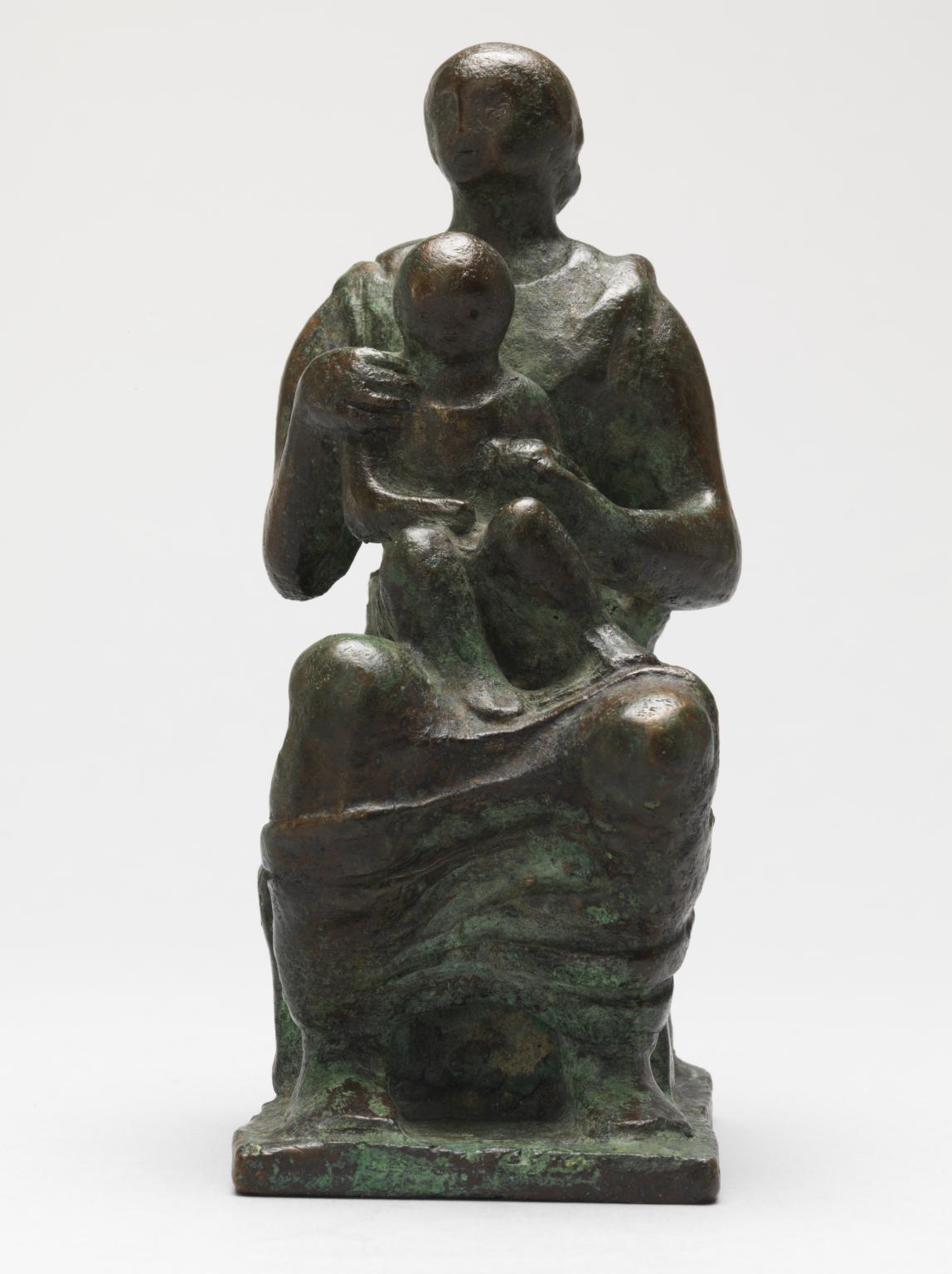
Henry Moore OM, CH, Maquette for Madonna and Child 1943, cast 1944–5
The mother and child had been a major theme in Moore’s work since the 1920s. Yet when the vicar of St Matthew, Northampton, invited Moore to make a sculpture of the Madonna and Child, he was reluctant to accept. He felt unsure how to adapt his secular interests to the Christian tradition. These bronzes are casts of the original terracotta models he made for the project. They are unusually naturalistic and steeped in references to Renaissance religious art. This suggests Moore was trying to produce a sculpture that people would find both modern and familiar.
Gallery label, September 2016
29/30
artworks in Henry Moore at Tate
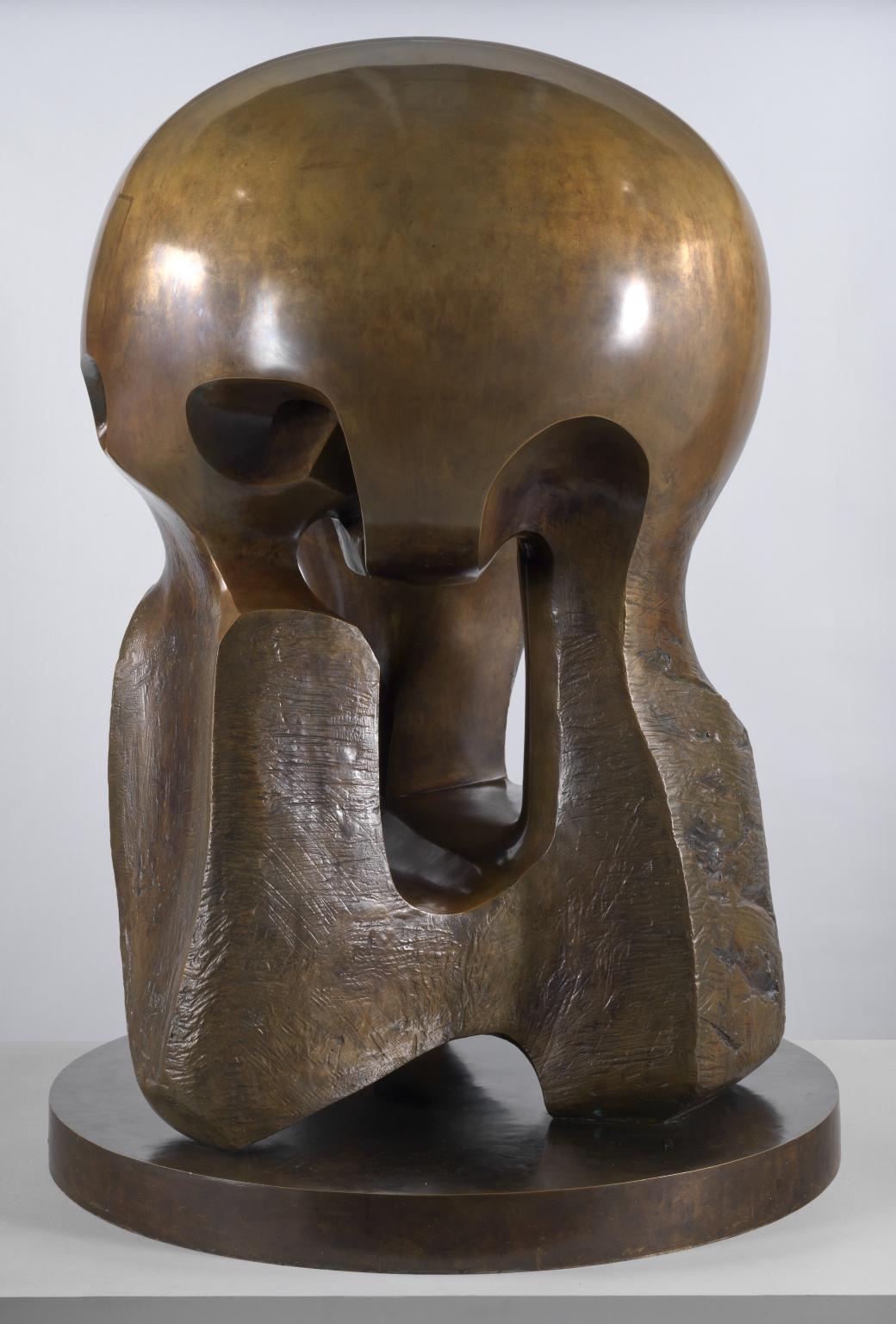
Henry Moore OM, CH, Atom Piece (Working Model for Nuclear Energy) 1964–5, cast 1965
In 1963 Moore was invited by the University of Chicago to make a sculpture commemorating the first controlled nuclear reaction, conducted at the university in 1942. This work is a model for the larger Nuclear Energy, unveiled in 1967. Moore intended it to convey ‘a contained power and force’ appropriate to the subject. The upper shape suggests a human skull or a mushroom cloud. The city of Hiroshima, which had been destroyed by a nuclear bomb in 1945, purchased one of the seven versions of this model in 1987.
Gallery label, February 2025
30/30
artworks in Henry Moore at Tate
Art in this room






























You've viewed 6/30 artworks
You've viewed 30/30 artworks
